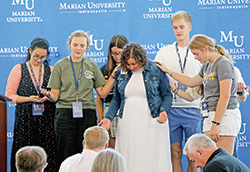Catechesis Supplement
Document helps parishes prepare for Year 2 of National Eucharistic Revival

For 30 years, Tom and Cindy Flaten of Christ the King Parish in Indianapolis had the marriage of their dreams before her death on Christmas Day in 2021. (Submitted photo)
By Natalie Hoefer
Year one of the three-year National Eucharistic Revival is underway.
But even as year one’s focus of eucharistic revival at the diocesan level has just begun, the archdiocese has already created a tool to help faith communities prepare for the revival’s parish focus during year two, which starts on June 1 next year and goes through mid-July of 2024.
The resource is a document called “10 Ways Parishes Can Enter Year 1 of the 3-Year National Eucharistic Revival.” (En Espanol)
“We’re using the phrase ‘year one’ because the document is about activities parishes can engage in during year one of the revival to help them prepare for year two and beyond,” says Ken Ogorek, archdiocesan director of catechesis.
“Parishes needn’t have a fully developed plan at this point,” he adds. “But using the ideas in the document can help them prepare now so they can hit the ground running come June next year.”
Some ideas listed include praying, listening, taking an inventory of current parish activities, conducting a survey for ideas from parishioners and more.
Ogorek says the archdiocesan Eucharistic Revival Planning Team collaborated on the resource. He calls the team “a small group of people in various ministries throughout central and southern Indiana—mostly outside the Catholic Center in Indianapolis.”
Jeff McQueen is on the team. The member of St. Susanna Parish in Plainfield serves as parish council chair and with other groups in the parish.
“I think the suggestions [in the ‘10 Ways’ document] are all wonderful for the purpose of assisting the parish as the Church’s greatest missionary tool for evangelization,” he says.
McQueen has great hopes for the revival’s year two focus at the parish level and for the National Eucharistic Revival in general.
“It is my hope that many new missionary disciples and disciple-makers may be developed by the renewal of the importance of the Eucharist in our lives,” he says. “My hope is that the Eucharistic Revival will foster transformation of parish members and bring them to a deeper relationship with Jesus through a clearer understanding of the Eucharist.”
Father Dustin Boehm, pastor of St. Gabriel Parish in Connersville and
St. Bridget of Ireland Parish in Liberty, is also on the archdiocese’s planning team for the revival.
“I think it’s a great thing that we are going to have parishes focus on the Eucharist for a whole year in the revival,” he says. “The document is about looking, listening and discerning opportunities for how to do that next year.”
Father Boehm says St. Gabriel and St. Bridget of Ireland parishes are already participating in the revival by praying the archdiocese’s “Prayer for Eucharistic Revival” (eucharisticrevivalindy.org/prayer) at the end of each Mass.
The parishes’ existing annual “31 Days of Perpetual Adoration” initiative is one example of an effort faith communities can start preparing for to engage parishioners with the Eucharist in year two of the revival.
“We also upped eucharistic adoration opportunities throughout the rest of the year,” says Father Boehm. “A lot of my homilies are on the Eucharist. [The efforts is] about trying to become more aware of fruits of the Eucharist. There’s been a good spirit and ever-elevating awareness of the gift of the Eucharist from this focus.”
Yadira Villatoro, administrator of religious education at St. Anthony Parish in Indianapolis and archdiocesan Eucharistic Revival Planning Team member, says discussions have taken place at her parish regarding plans for year two of the revival.
“We want to include adoration during the confirmation retreat for teens to make them aware of how beautiful it is to have Jesus right there in the Eucharist,” she says. “Sometimes they think nobody is in the tabernacle. I hope spending time with Jesus in adoration will give them more reverence.”
Villatora says the faith community will also encourage more people to participate in the parish’s adoration hours and to visit the chapel in the parish center more frequently, “even for just 10-15 minutes.”
She offers one parish practice for other faith communities to consider planning for year two of the revival.
“We’re a multi-cultural parish,” says Villatoro. “So, every year in June we come together for a special eucharistic procession on the feast of Corpus Christi. We have people from all the different countries bring their country’s flag to show we’re all united in Christ.”
That oneness in Christ is a fruit Father Boehm hopes to see come from the National Eucharistic Revival in general.
“We’re so far apart sometimes,” he says. “We live in a time when political, racial, cultural, social and economic differences seem to be dividing us into camps or tribes. This revival will only help alleviate that.
“It’s the Lord’s great prayer that ‘they may be one’ (Jn 17:11). This focus on the Eucharist will help battle that in our parishes, communities, archdiocese and beyond.”
(For more information on the National Eucharistic Revival in the archdiocese, go to eucharisticrevivalindy.org/resources-for-parishes.) †
Read more from our Catechesis Supplement
